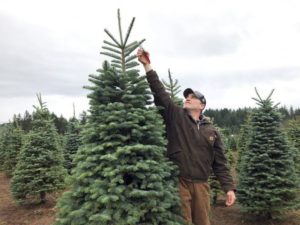Christmas tree farmers combat popularity of artificial trees

Casey Grogan, owner of Silver Bells Tree Farm and president of the Pacific Northwest Christmas Tree Association, trims a noble fir at his 400-acre Christmas tree farm in Silverton, Oregon in this November 2018 photo.
/AP
Tualatin, Oregon — Rosa Villarreal’s three young sons jumped and ran around the field of Christmas trees like jackrabbits, their excitement palpable as they raced from evergreen to evergreen.
The boys, ages 2, 4 and 6, were picking out a real tree this year — a new tradition their young parents hope will create lasting memories.
“I saw this video where the big tree, the mom decorates it, and the little tree, the kids get to decorate it,” she said, as her husband, Jason Jimenez, snapped a photo of their toddler posing with a tiny tree just his size.
Christmas tree farmers across the U.S. worry families like Villarreal’s are slowly dwindling. Artificial trees, once crude imitations of an evergreen, are now so realistic that it’s hard to tell they are fakes even though many are conveniently pre-strung with lights and can fold up for storage at the push of a button.
Between 75 and 80 percent of Americans who have a Christmas tree now have an artificial one, and the $1 billion market for fake trees is growing at about 4 percent a year — even though they can be reused again and again.
To combat this trend, Christmas tree farmers have joined forces as the Christmas Tree Promotion Board and are running a social media ad campaign this holiday season to tout the benefits of a real evergreen.
The campaign, called “It’s Christmas. Keep It Real!,” is funded by a 15-cent fee that tree farmers pay for each tree they harvest.
It’s a modern-day attempt at such famous agricultural ad campaigns as “Got Milk?” and “Beef. It’s What’s For Dinner.”
A series of short movies on Instagram and Facebook follow real families as they hunt for the perfect tree, cut it down and decorate it.
The target audience is the “millennial mom” because tree farmers are increasingly worried that young adults starting their own family traditions will opt for an artificial tree, costing farmers a generation of customers, said Marsha Gray, executive director of the Christmas Tree Promotion Board, based in Michigan.
“The target we’re talking about right now is millennials: first house, first baby. That’s kind of the decision-making time,” she said, adding that the videos show families cutting their own trees and buying pre-cut trees from lots.
“We realize they may have never done this before. And we need to help them discover it and figure out how to include it in their holiday.”
It’s impossible to know exactly how many real Christmas trees are sold each year because there is no central clearinghouse or agency collecting that information.
But the National Christmas Tree Association estimates about 25 million evergreens are harvested each year — and presumably, most of those are sold.
Disclaimer: The comments uploaded on this site do not necessarily represent or reflect the views of management and owner of Cebudailynews. We reserve the right to exclude comments that we deem to be inconsistent with our editorial standards.
